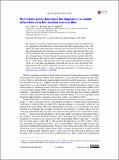| dc.contributor.author | Teh, Weng Hong | |
| dc.contributor.author | Boning, Duane S | |
| dc.contributor.author | Welsch, Roy E | |
| dc.date.accessioned | 2019-03-06T17:58:14Z | |
| dc.date.available | 2019-03-06T17:58:14Z | |
| dc.date.issued | 2015-05 | |
| dc.date.submitted | 2015-02 | |
| dc.identifier.issn | 2158-3226 | |
| dc.identifier.uri | http://hdl.handle.net/1721.1/120759 | |
| dc.description.abstract | We report the extension of multi-strata subsurface infrared (1.342 μm) pulsed laser die singulation to the fabrication of defect-free ultra-thin stacked memory dies. We exploit the multi-strata interactions between generated thermal shockwaves and the preceding high dislocation density layers formed to initiate crack fractures that separate the individual dies from within the interior of the die. We show that optimized inter-strata distances between the high dislocation density layers together with effective laser energy dose can be used to compensate for the high backside reflectance (up to ∼ 82%) wafers. This work has successfully demonstrated defect-free eight die stacks of 25 μm thick mechanically functional and 46 μm thick electrically functional memory dies. | en_US |
| dc.description.sponsorship | Sandisk SemiConductor Shanghai Co Ltd. | en_US |
| dc.description.sponsorship | Leaders for Global Operations Program | en_US |
| dc.description.sponsorship | Noyce Foundation (Robert N. Noyce full scholarship) | en_US |
| dc.publisher | AIP Publishing | en_US |
| dc.relation.isversionof | http://dx.doi.org/10.1063/1.4921205 | en_US |
| dc.rights | Creative Commons Attribution 3.0 unported license | en_US |
| dc.rights.uri | https://creativecommons.org/licenses/by/3.0/ | en_US |
| dc.source | American Institute of Physics (AIP) | en_US |
| dc.title | Multi-strata subsurface laser die singulation to enable defect-free ultra-thin stacked memory dies | en_US |
| dc.type | Article | en_US |
| dc.identifier.citation | Teh, W. H., D. Boning, and R. Welsch. “Multi-Strata Subsurface Laser Die Singulation to Enable Defect-Free Ultra-Thin Stacked Memory Dies.” AIP Advances 5, no. 5 (May 2015): 057128. | en_US |
| dc.contributor.department | Massachusetts Institute of Technology. Department of Electrical Engineering and Computer Science | en_US |
| dc.contributor.department | Massachusetts Institute of Technology. Department of Urban Studies and Planning | en_US |
| dc.contributor.department | Massachusetts Institute of Technology. Institute for Data, Systems, and Society | en_US |
| dc.contributor.department | Sloan School of Management | en_US |
| dc.contributor.mitauthor | Teh, Weng Hong | |
| dc.contributor.mitauthor | Boning, Duane S | |
| dc.contributor.mitauthor | Welsch, Roy E | |
| dc.relation.journal | AIP Advances | en_US |
| dc.eprint.version | Final published version | en_US |
| dc.type.uri | http://purl.org/eprint/type/JournalArticle | en_US |
| eprint.status | http://purl.org/eprint/status/PeerReviewed | en_US |
| dc.date.updated | 2019-03-06T13:51:27Z | |
| dspace.orderedauthors | Teh, W. H.; Boning, D.; Welsch, R. | en_US |
| dspace.embargo.terms | N | en_US |
| dc.identifier.orcid | https://orcid.org/0000-0002-0417-445X | |
| dc.identifier.orcid | https://orcid.org/0000-0002-9038-1622 | |
| mit.license | PUBLISHER_CC | en_US |
